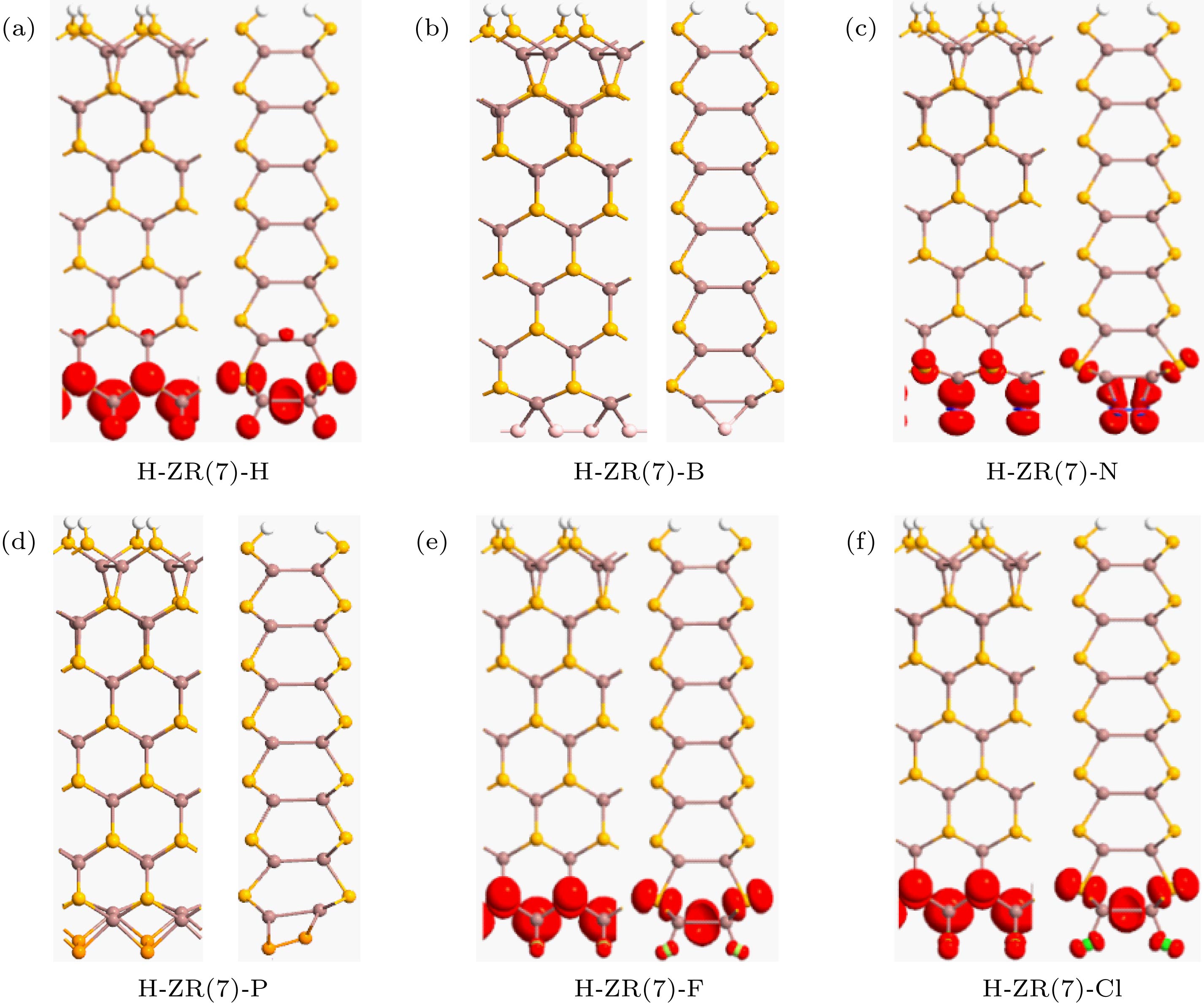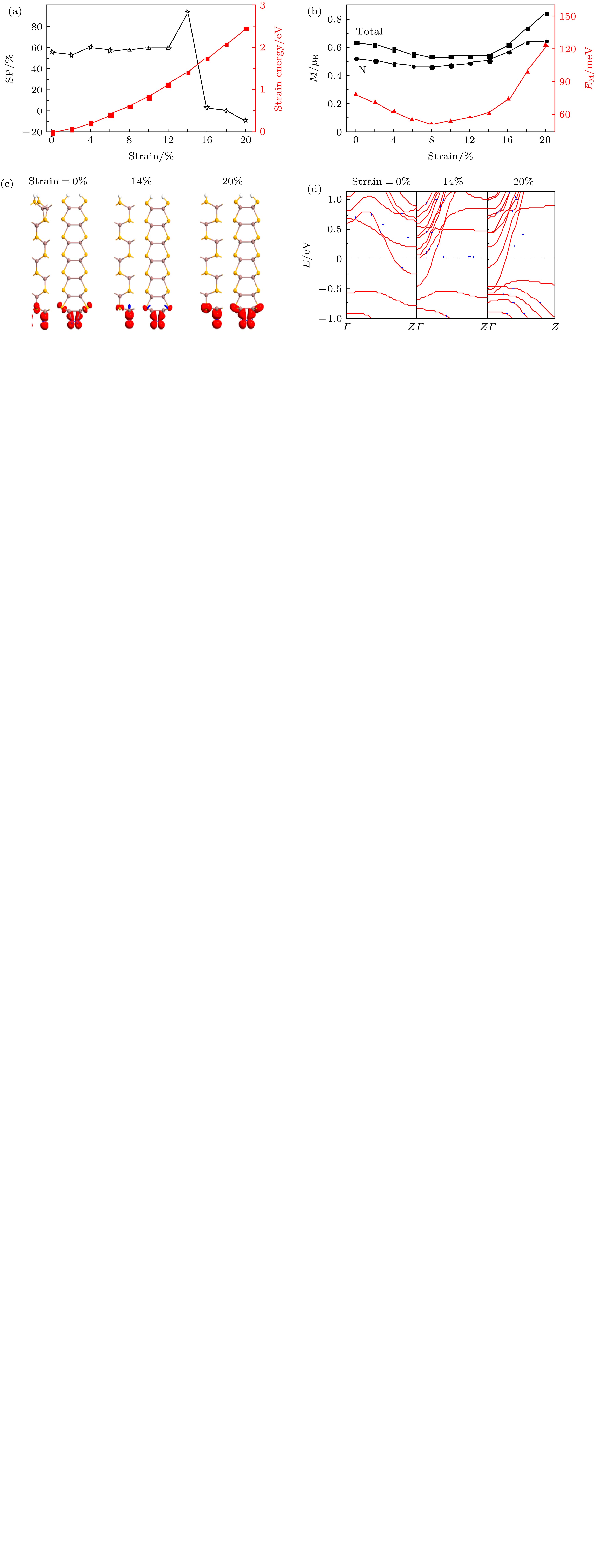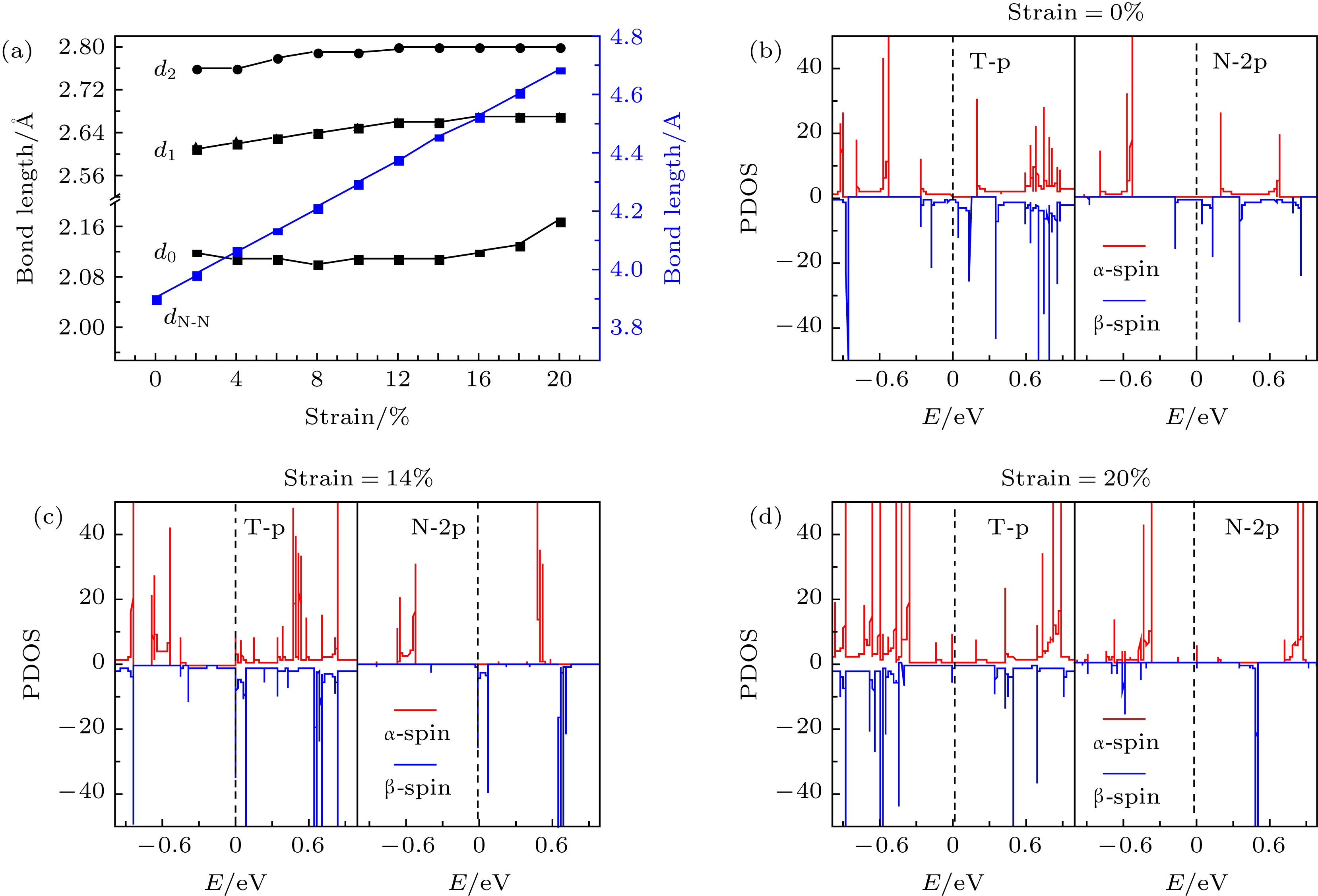-
Employing the first-principles calculation based on the density functional theory, the geometries, magneto-electronicproperties, and strain effects of the zigzag-edged InSe nanoribbons with the Se-edge saturated by H atoms and In-edge terminated by various non-metallic elements X (X = H, B, N, P, F and Cl) are studied. The calculated formation energy and Forcite annealing simulations show that the H-ZN(7)-X has a stable geometry. For F- and Cl- terminated ribbons, they have a magnetic metallic property similar to that in the case of H termination, and for the N termination the nanoribbon has the strongest magnetic property. However, the B and P terminations cause the magnetic properties at the ribbon edge to completely disappear, particularly when the mechanical strain is applied. The magnetic stability of H-ZN(7)-N is enhanced, and the spin polarization efficiency (SP) at the Fermi level can be effectively modulated in a range from zero to 92%, which means that it is possible to design a mechanical switch for controlling the spin transport at low bias. The strain modulating mechanism is related to the fact that the variation of strain-induced bond length leads the unpaired electrons to be redistributed or disappear. The magnetic properties of N-ZN(7)-N are mainly derived from the p orbitals of In, Se and N atoms, thus it is very important to develop non-transition metal magnetic materials.
-
Keywords:
- InSe nanoribbon /
- non-metallic atom /
- magneto-electronic property /
- strain effect
[1] Weiss N O, Zhou H L, Liao L, Liu Y, Jiang S, Huang Y, Duan X F 2012 Adv. Mater. 24 5782
 Google Scholar
Google Scholar
[2] Lee C, Wei X D, Kysar J W, Hone J 2008 Science 321 385
 Google Scholar
Google Scholar
[3] Yu W, Niu C, Zhu Z, Wang X, Zhang W B 2016 J. Mater. Chem. C 4 6581
 Google Scholar
Google Scholar
[4] Kuang W, Hu R, Fan Z, Zhang Z 2019 Nanotechnology 30 145201
 Google Scholar
Google Scholar
[5] Yu W W, Chen X A, Mei W, Chen C S, Tsang Y H 2017 Appl. Surf. Sci. 400 129
 Google Scholar
Google Scholar
[6] Hu R, Li Y H, Zhang Z H, Fan Z Q, Sun L 2019 J. Mater. Chem. C 7 7745
[7] Sheng Y, You Y, Cao Z, Liu L, Wu H 2018 Analyst 143 2411
 Google Scholar
Google Scholar
[8] Chen C S, Yu W W, Liu T G, Cao S Y, Tsang Y H 2017 Sol. Energy Mater. Sol. Cells 160 43
 Google Scholar
Google Scholar
[9] Magda G Z, Jin X, Hagy I, Vancsó P, Osváth Z, Nemes P, Hwang C P, Biró L, Tapasztó L 2014 Nature 514 608
 Google Scholar
Google Scholar
[10] Ding Y, Ni J 2009 Appl. Phys. Lett. 95 083115
 Google Scholar
Google Scholar
[11] Pan H, Zhang Y W 2012 J. Mater. Chem. 22 7280
 Google Scholar
Google Scholar
[12] Yuan P F, Hu R, Fan Z Q, Zhang Z H 2018 J. Phys. Condens. Matter 30 445802
 Google Scholar
Google Scholar
[13] Liu W, Deng X, Cai S 2016 AIP Adv. 6 075103
 Google Scholar
Google Scholar
[14] Chen Q, Tang L, Chen K, Zhao H 2013 J. Appl. Phys. 114 084301
 Google Scholar
Google Scholar
[15] Zhu Z, Zhang Z H, Wang D, Deng X Q, Fan Z Q, Tang G P 2015 J. Mater. Chem. 3 9657
[16] Zhang H, Meng S, Yang H 2015 J. Appl. Phys. 117 112108
[17] Wu M, Wu X, Zeng X C 2010 J. Phys. Chem. C 114 3937
 Google Scholar
Google Scholar
[18] Zhu Z L, Li C, Yu W, Chang D, Sun Q, Jia Y 2014 Appl. Phys. Lett. 105 113105
 Google Scholar
Google Scholar
[19] Lei S, Ge L, Najmaei S 2014 ACS Nano 8 1263
 Google Scholar
Google Scholar
[20] Ho C H 2016 2D Mater. 3 025019
 Google Scholar
Google Scholar
[21] Mudd G W, Molas M R, Chen X, Zólyomi V 2016 Sci. Rep. 6 39619
 Google Scholar
Google Scholar
[22] Bandurin D A, Tyurnina A V, Yu G L 2016 Nat. Nanotechnol. 12 223
[23] Wu M, Shi J, Zhang M, Ding Y, Wang H, Cen Y, Guo W, Pan S, Zhu Y 2018 Nanotechnology 29 205708
 Google Scholar
Google Scholar
[24] Yao A L, Wang X F, Liu Y S, Sun Y N 2018 Nanoscale Res. Lett. 13 107
 Google Scholar
Google Scholar
[25] Zhou W, Yu G, Rudenko A N, Yuan S 2018 Phys. Rev. Mater. 2 114001
 Google Scholar
Google Scholar
[26] Brandbyge M, Mozos J L, Ordejón P, Taylor J, Stokbro K. 2002 Phys. Rev. B 65 165401
 Google Scholar
Google Scholar
[27] Taylor J, Guo H, Wang J 2001 Phys. Rev. B 63 245407
 Google Scholar
Google Scholar
[28] Chen S, Zhou W, Yu J, Chen K Q 2018 Carbon 129 809
 Google Scholar
Google Scholar
[29] Deng Y, Chen S, Zeng Y, Feng Y, Zhou W, Tang L, Chen K 2018 Org. Electron. 63 310
 Google Scholar
Google Scholar
[30] Yuan J, Zhang L W, Liew K M 2016 Curr. Nanosci. 12 636
 Google Scholar
Google Scholar
[31] 张华林, 孙琳, 韩佳凝 2017 物理学报 66 246101
 Google Scholar
Google Scholar
Zhang H L, Sun L, Han J N 2017 Acta Phys. Sin. 66 246101
 Google Scholar
Google Scholar
[32] 左博敏, 健美, 冯志, 毛宇亮 2019 物理学报 68 113103
 Google Scholar
Google Scholar
Zuo B M, Yuan J M, Feng Z, Mao Y L 2019 Acta Phys. Sin. 68 113103
 Google Scholar
Google Scholar
[33] Kang H S, Jeong S 2004 Phys. Rev. B 70 233411
 Google Scholar
Google Scholar
-
图 1 (a) InSe单层的顶视图(上图)和侧视图(下图).沿着X方向裁剪InSe单层可以得到锯齿型InSe纳米带, 图中淡绿色填充区域表示; (b) H-ZN(7)-X的顶视图(左图)和侧视图(右图). 红色的虚线框表示计算的单胞
Figure 1. (a) Top and side views of monolayer InSe. Tailoring monolayer InSe along X-axis direction to achieve zigzag InSe nanoribbons, denoted by a pale green filled area; (b) top and side views of H-ZN(7)-X. The red dotted box represents a unit cell.
图 2 使用BOMD模拟检测H-ZN(7)-X的热稳定性. 在8 ps模拟后, 对于H-ZN(7)-H, H-ZN(7)-N, H-ZN(7)-F, H-ZN(7)-P和H-ZN(7)-Cl, 在600 K时出现小变形, 对于H-ZN(7)-B在500 K处出现小变形, 但是没有观察到边缘重构
Figure 2. BOMD simulations for examining thermal stability of the H-ZN(7)-X. The small deformations occur at 500 K for H-ZN(7)-B and 600 K for other ribbons after 8 ps of simulation, but no edge reconstruction is observed.
图 3 (a)−(f)分别为H-ZN(7)-H, H-ZN(7)-B, H-ZN(7)-N, H-ZN(7)-P, H-ZN(7)-F, 和H-ZN(7)-Cl在NM (无磁)态下的的能带结构(BS)、态密度(DOS)和最外边缘Se (In)原子的投影态密度(PDOS); (g)费米能级附近能带a1 (a2)相对应的部分电荷密度分布. 等值面设置为0.05|e|Å–3.
Figure 3. (a)−(f) Correspond to the band structure (BS), density of the state (DOS), and projected density of the state (PDOS) of H-ZN(7)-H, H-ZN(7)-B, H-ZN(7)-N, H-ZN(7)-P, H-ZN(7)-F, and H-ZN(7)-Cl, respectively; (g) the partial charge density distribution corresponds to subbands a1 (a2) labeled in figures (a)−(f), respectively. The isosurface value is set as 0.05|e|Å–3.
图 4 自旋极化电荷密度等值面图, 等值面取为 ± 0.005|e|/Å3 (a) H-ZN(7)-H; (b) H-ZN(7)-B; (c) H-ZN(7)-N; (d) H-ZN(7)-P; (e) H-ZN(7)-F; (f) H-ZN(7)-Cl
Figure 4. The isosurface plots for the spin polarized density. The isosurface value is 0.005|e|/Å3: (a) H-ZN(7)-H; (b) H-ZN(7)-B; (c) H-ZN(7)-N; (d) H-ZN(7)-P; (e) H-ZN(7)-F; (f) H-ZN(7)-Cl
图 6 (a)拉伸总能和费米能级处自旋极化率随拉伸形变的变化; (b)磁矩及磁化能随拉伸形变的变化; (c), (d)几个典型形变0%, 14%, 20%下的自旋极化电荷密度和能带变化. 等值面被设为 ± 0.005|e|/Å3
Figure 6. (a) The evolution of spin polarization efficiency (SP) at the Fermi level and the strain energy versus strain; (b) the magnetic moment (M) and magnetized energy(EM) in one unit cell versus strain; (c) the spin polarized density and (d) the band structure at several typical strains. The isosurface value is set as 0.005|e|Å–3.
表 2 H-ZN(7)-X在铁磁态(FM)的结构参数. M, µ(InL), µ(SeL), µ(X)分别为总磁矩和下边缘In, Se和X的磁矩(单位: μB/单胞). EM和SP分别是磁化能(单位: meV/单胞)与费米能级处的自旋极化率
Table 2. The structural parameters of H-ZN(7)-X in the FM state. M represents the net magnetic moment of unit cell, µ(InL), µ(SeL) and µ(X) represent the net magnetic moment of lower (L) edge In, Se and X atoms, respectively(unit: μB/unit cell). EM represent the magnetized energy (unit: meV/unit cell) and SP is the spin polarization efficiency at the Fermi level.
Structure EM µ(InL) µ(SeL) µ(X) M SP H-ZN(7)-H 7.95 0.15 0.21 0.07 0.47 43.0% B-ZN(7)-B 0 0 0 0 0 0% H-ZN(7)-N 78.32 0.02 0.10 0.52 0.632 55.6% H-ZN(7)-P 0 0 0 0 0 0% H-ZN(7)-F 8.82 0.14 0.25 0.03 0.44 38.8% H-ZN(7)-Cl 8.70 0.15 0.25 0.05 0.47 39.5% 表 1 H-ZN(7)-X的形成能(EFE) (单位: eV/原子)和键长或两相关原子间的空间位置(单位: Å)
Table 1. The formation energy (EFE) (unit: eV/atom) of H-ZN (7)-X and the bond length or space position between the two related atoms (unit: Å).
Structure EEF(ribbon) dX-X d0 d1 d2 d3 H-ZN(7)-H –3.12 3.93 1.72 2.83 2.60 2.57 H-ZN(7)-B –4.25 1.85 2.37 3.02 2.57 2.62 H-ZN(7)-N –5.47 3.90 2.12 2.75 2.60 2.66 H-ZN(7)-P –4.69 3.83 2.66 2.86 2.66 2.59 H-ZN(7)-F –4.86 3.93 1.72 2.82 2.60 2.57 H-ZN(7)-Cl –3.82 3.94 2.16 2.82 2.61 2.57 -
[1] Weiss N O, Zhou H L, Liao L, Liu Y, Jiang S, Huang Y, Duan X F 2012 Adv. Mater. 24 5782
 Google Scholar
Google Scholar
[2] Lee C, Wei X D, Kysar J W, Hone J 2008 Science 321 385
 Google Scholar
Google Scholar
[3] Yu W, Niu C, Zhu Z, Wang X, Zhang W B 2016 J. Mater. Chem. C 4 6581
 Google Scholar
Google Scholar
[4] Kuang W, Hu R, Fan Z, Zhang Z 2019 Nanotechnology 30 145201
 Google Scholar
Google Scholar
[5] Yu W W, Chen X A, Mei W, Chen C S, Tsang Y H 2017 Appl. Surf. Sci. 400 129
 Google Scholar
Google Scholar
[6] Hu R, Li Y H, Zhang Z H, Fan Z Q, Sun L 2019 J. Mater. Chem. C 7 7745
[7] Sheng Y, You Y, Cao Z, Liu L, Wu H 2018 Analyst 143 2411
 Google Scholar
Google Scholar
[8] Chen C S, Yu W W, Liu T G, Cao S Y, Tsang Y H 2017 Sol. Energy Mater. Sol. Cells 160 43
 Google Scholar
Google Scholar
[9] Magda G Z, Jin X, Hagy I, Vancsó P, Osváth Z, Nemes P, Hwang C P, Biró L, Tapasztó L 2014 Nature 514 608
 Google Scholar
Google Scholar
[10] Ding Y, Ni J 2009 Appl. Phys. Lett. 95 083115
 Google Scholar
Google Scholar
[11] Pan H, Zhang Y W 2012 J. Mater. Chem. 22 7280
 Google Scholar
Google Scholar
[12] Yuan P F, Hu R, Fan Z Q, Zhang Z H 2018 J. Phys. Condens. Matter 30 445802
 Google Scholar
Google Scholar
[13] Liu W, Deng X, Cai S 2016 AIP Adv. 6 075103
 Google Scholar
Google Scholar
[14] Chen Q, Tang L, Chen K, Zhao H 2013 J. Appl. Phys. 114 084301
 Google Scholar
Google Scholar
[15] Zhu Z, Zhang Z H, Wang D, Deng X Q, Fan Z Q, Tang G P 2015 J. Mater. Chem. 3 9657
[16] Zhang H, Meng S, Yang H 2015 J. Appl. Phys. 117 112108
[17] Wu M, Wu X, Zeng X C 2010 J. Phys. Chem. C 114 3937
 Google Scholar
Google Scholar
[18] Zhu Z L, Li C, Yu W, Chang D, Sun Q, Jia Y 2014 Appl. Phys. Lett. 105 113105
 Google Scholar
Google Scholar
[19] Lei S, Ge L, Najmaei S 2014 ACS Nano 8 1263
 Google Scholar
Google Scholar
[20] Ho C H 2016 2D Mater. 3 025019
 Google Scholar
Google Scholar
[21] Mudd G W, Molas M R, Chen X, Zólyomi V 2016 Sci. Rep. 6 39619
 Google Scholar
Google Scholar
[22] Bandurin D A, Tyurnina A V, Yu G L 2016 Nat. Nanotechnol. 12 223
[23] Wu M, Shi J, Zhang M, Ding Y, Wang H, Cen Y, Guo W, Pan S, Zhu Y 2018 Nanotechnology 29 205708
 Google Scholar
Google Scholar
[24] Yao A L, Wang X F, Liu Y S, Sun Y N 2018 Nanoscale Res. Lett. 13 107
 Google Scholar
Google Scholar
[25] Zhou W, Yu G, Rudenko A N, Yuan S 2018 Phys. Rev. Mater. 2 114001
 Google Scholar
Google Scholar
[26] Brandbyge M, Mozos J L, Ordejón P, Taylor J, Stokbro K. 2002 Phys. Rev. B 65 165401
 Google Scholar
Google Scholar
[27] Taylor J, Guo H, Wang J 2001 Phys. Rev. B 63 245407
 Google Scholar
Google Scholar
[28] Chen S, Zhou W, Yu J, Chen K Q 2018 Carbon 129 809
 Google Scholar
Google Scholar
[29] Deng Y, Chen S, Zeng Y, Feng Y, Zhou W, Tang L, Chen K 2018 Org. Electron. 63 310
 Google Scholar
Google Scholar
[30] Yuan J, Zhang L W, Liew K M 2016 Curr. Nanosci. 12 636
 Google Scholar
Google Scholar
[31] 张华林, 孙琳, 韩佳凝 2017 物理学报 66 246101
 Google Scholar
Google Scholar
Zhang H L, Sun L, Han J N 2017 Acta Phys. Sin. 66 246101
 Google Scholar
Google Scholar
[32] 左博敏, 健美, 冯志, 毛宇亮 2019 物理学报 68 113103
 Google Scholar
Google Scholar
Zuo B M, Yuan J M, Feng Z, Mao Y L 2019 Acta Phys. Sin. 68 113103
 Google Scholar
Google Scholar
[33] Kang H S, Jeong S 2004 Phys. Rev. B 70 233411
 Google Scholar
Google Scholar
Catalog
Metrics
- Abstract views: 13471
- PDF Downloads: 88
- Cited By: 0















 DownLoad:
DownLoad:






